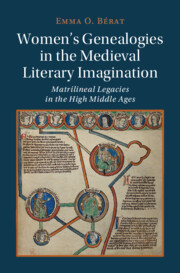 Women's Genealogies in the Medieval Literary Imagination
Women's Genealogies in the Medieval Literary Imagination Matrilineal Legacies
Published online by Cambridge University Press: 14 March 2024
Working from the premise that women’s genealogies take as many forms as the political, historical, and ideological interests of those who wrote, illustrated, or patronized them, this concluding chapter outlines some characteristics of such genealogies and new areas of investigation. Genealogies that construct and convey women’s political and spiritual claims frequently accommodate and even emphasize geographical change, disruptions in succession, and the material nature of textuality. Recognizing the political importance and prevalence of matrilineages in medieval texts in turn offers a broader and more nuanced understanding of medieval concepts of maternity and women’s roles as childbearers.
To save this book to your Kindle, first ensure [email protected] is added to your Approved Personal Document E-mail List under your Personal Document Settings on the Manage Your Content and Devices page of your Amazon account. Then enter the ‘name’ part of your Kindle email address below. Find out more about saving to your Kindle.
Note you can select to save to either the @free.kindle.com or @kindle.com variations. ‘@free.kindle.com’ emails are free but can only be saved to your device when it is connected to wi-fi. ‘@kindle.com’ emails can be delivered even when you are not connected to wi-fi, but note that service fees apply.
Find out more about the Kindle Personal Document Service.
To save content items to your account, please confirm that you agree to abide by our usage policies. If this is the first time you use this feature, you will be asked to authorise Cambridge Core to connect with your account. Find out more about saving content to Dropbox.
To save content items to your account, please confirm that you agree to abide by our usage policies. If this is the first time you use this feature, you will be asked to authorise Cambridge Core to connect with your account. Find out more about saving content to Google Drive.